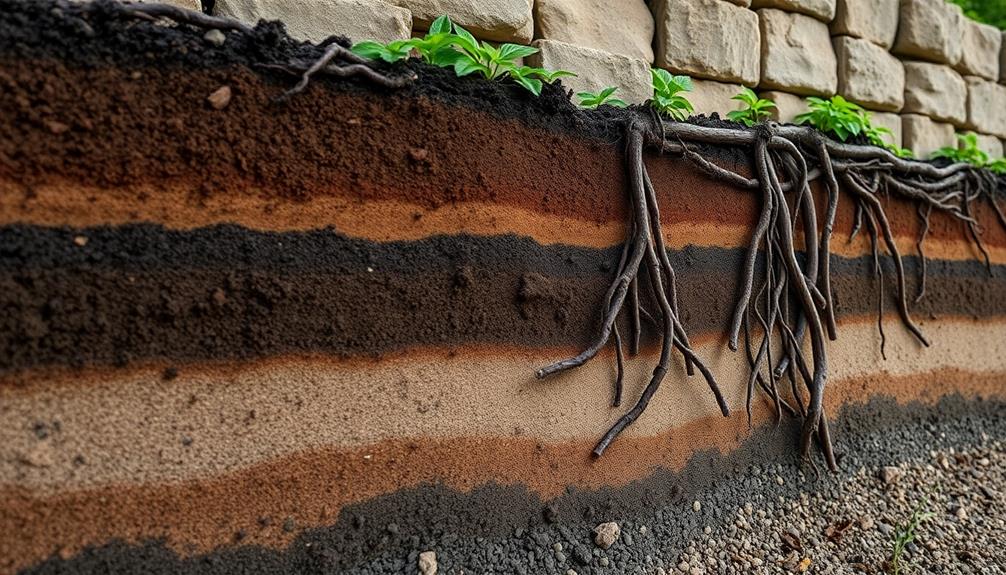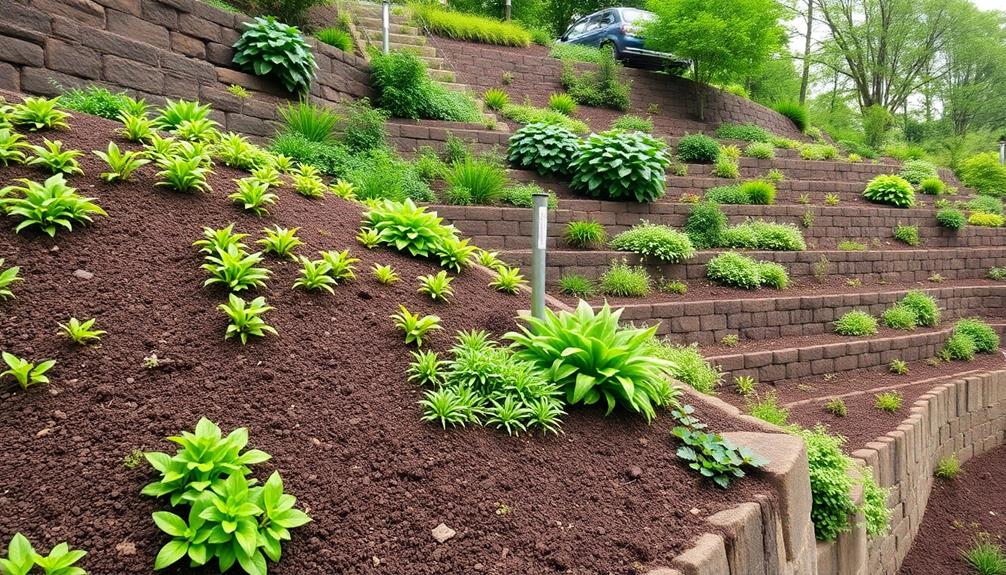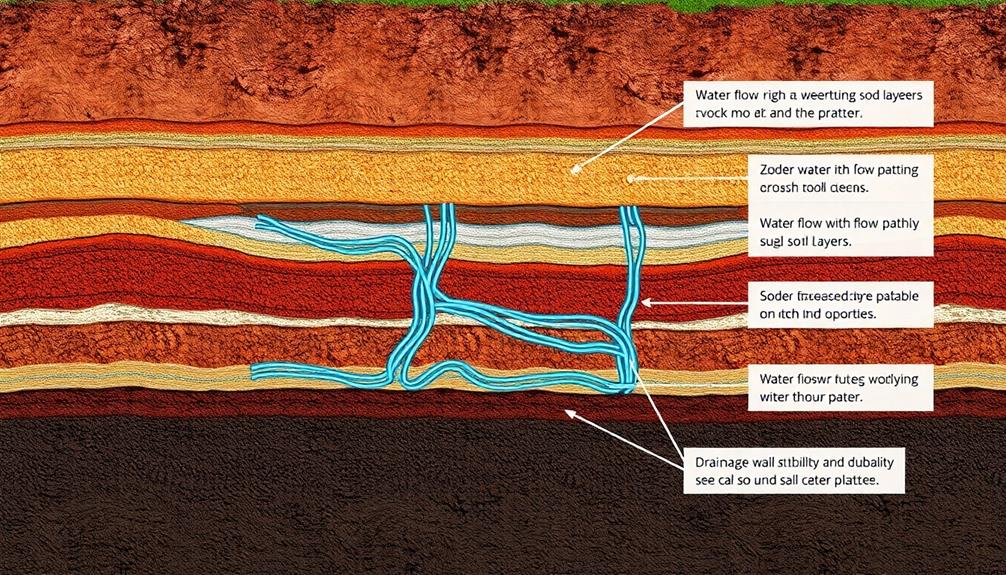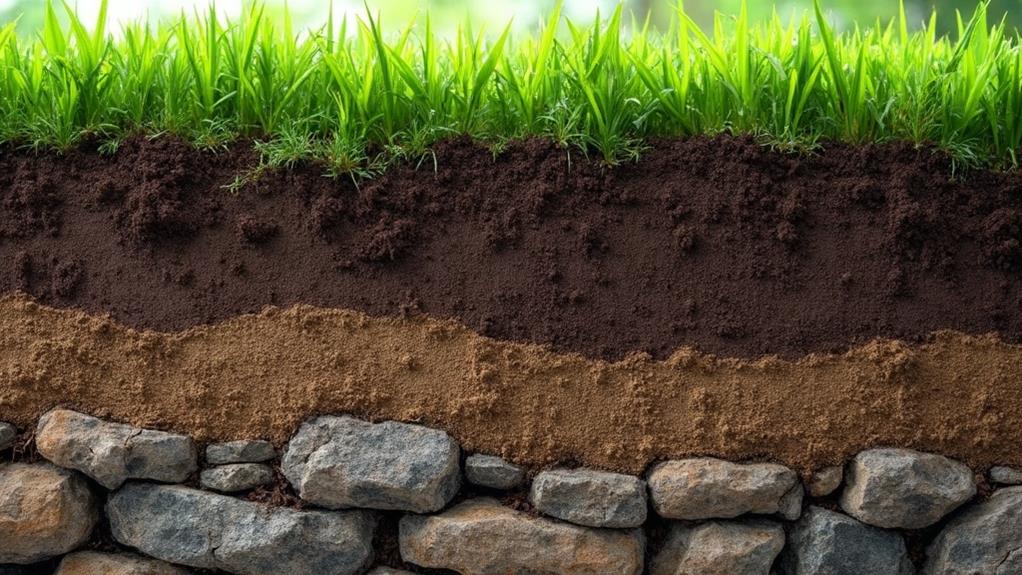Soil quality plays a pivotal role in retaining wall construction, profoundly affecting structural integrity and longevity. Different soil types, such as sandy, clayey, and loamy, present unique challenges and advantages, influencing permeability, cohesion, and compaction needs. High-quality soil guarantees a stable foundation, offering perfect drainage and support, thus reducing the risk of erosion and structural failure. Proper assessment of soil composition enables tailored design solutions, which address drainage and compaction requirements, thereby fostering durability. Understanding the synergistic relationship between soil and retaining wall subsystems can elevate performance and longevity, inviting further exploration into effective construction techniques.
Table of Contents
ToggleWalls Contractor Highlights
- Soil quality directly affects the retaining wall's structural integrity and stability.
- High-quality soil provides a strong foundation, reducing risks of settling and erosion.
- Proper drainage systems are reliant on soil composition for effective water management.
- Enhanced soil compaction minimizes voids, increasing the wall's load-bearing capacity.
- High-quality soil reduces long-term maintenance costs by preventing structural damage.
Soil Composition's Importance

The composition of soil holds significant importance in the construction of retaining walls, as it directly influences the types of soil best suited for such projects, impacts drainage and stability, and determines the soil compaction requirements essential for structural integrity.
For instance, boulders used in retaining wall construction can hold ground over the long term, making them a preferred choice. Understanding the different soil types, ranging from clay to gravel, allows for strategic selection that enhances drainage capabilities while maintaining required stability to prevent erosion and slippage.
Moreover, recognizing specific compaction needs tailored to the soil type certifies that the retaining wall can adequately support the lateral earth pressures exerted upon it.
Types of Soil
Understanding soil composition is pivotal for the success of retaining wall construction, as it directly impacts stability and structural integrity. The types of soil present can range from sandy to clayey, each possessing distinct characteristics that influence the design and functionality of the retaining wall.
Sandy soil, characterized by large particles and expansive pores, offers high permeability but lacks cohesion, making it susceptible to erosion and displacement under stress. Consequently, effective reinforcement and anchorage are necessary to guarantee stability.
Conversely, clayey soil is composed of microscopic particles and exhibits high cohesiveness, providing excellent compressibility resistance. However, its minimal permeability can pose challenges relating to water retention and potential swelling, necessitating careful consideration during construction.
Loamy soil, often considered ideal for many construction applications, presents a balanced mixture of sand, silt, and clay, offering moderate permeability and stability.
For retaining wall projects, meticulous analysis of the site's soil type enables engineers to tailor design specifications, solidifying the wall's stance against nature's forces. Emphasizing soil type awareness fosters a collaborative community among those involved in construction, empowering them to make informed decisions that harmonize with both human ambitions and the natural landscape.
Drainage and Stability
Effective drainage systems are pivotal in maintaining the stability of retaining walls, directly influenced by the soil composition on-site. Soil composition dictates the permeability and porosity of the ground, which are essential to designing efficient drainage to prevent water buildup behind retaining walls. When water accumulates due to inadequate drainage, it adds weight and pressure against the wall, potentially leading to structural failure. Consequently, identifying the soil type—whether it is clay, sand, or loam—allows engineers to evaluate the drainage requirements accurately.
Clay soils with low permeability can trap water, requiring additional drainage solutions, such as weep holes and geotextiles, to alleviate hydrostatic pressure. Conversely, sandy soils, with their high permeability, support natural drainage but may need stabilizing measures to avoid erosion. Loamy soils strike a delicate balance, offering moderate drainage efficiency but still demanding site-specific engineering assessments. By understanding these characteristics, construction professionals foster a sense of confidence and unity in achieving durable and resilient structures.
Thus, evaluating and integrating soil composition data enables the implementation of suitable drainage strategies, promoting the stability and longevity of retaining wall systems. Such carefully crafted designs protect infrastructures, fostering a sense of safety and community trust.
Soil Compaction Needs
Addressing soil composition intricately ties into the structural integrity of a retaining wall, particularly through the lens of soil compaction needs. Compaction is the process of densifying soil to increase its load-bearing capacity, pivotal in preserving the stability of retaining walls.
Effective compaction minimizes void spaces in the soil, thereby enhancing its resistance to hydraulic currents that might otherwise undermine the wall's foundation. Properly compacted soil also guarantees uniform settling, which is essential for maintaining the wall's structural equilibrium over time.
The importance of soil composition cannot be underestimated, as different soil types possess varying compaction abilities. Granular soils, for instance, such as sand and gravel, exhibit excellent compaction characteristics due to their frictional properties, promoting stability. Conversely, clay and silt require more meticulous compaction efforts to achieve desired results due to their cohesive nature, which may pose challenges under moisture fluctuations.
Understanding these dynamics fosters an inclusive mindset for engineers and builders, emphasizing the importance of thorough soil analysis and customization of compaction techniques. In essence, achieving ideal soil compaction is a foundational step, weaving a sense of unity and confidence among those who engage in constructing resilient, enduring retaining walls.
Benefits

Understanding the benefits of high-quality soil in retaining wall construction is essential, as it directly contributes to enhanced structural integrity and improved longevity and durability of the wall. Quality soil facilitates efficient water drainage, which mitigates hydrostatic pressure and reduces the risk of damage, thereby promoting the overall stability of the structure.
In addition, appropriate soil and drainage and reinforcement systems can complement interlocking concrete block retaining walls, making them durable and easy to install. With high-quality soil, the risk of erosion and shifting is considerably reduced. Consequently, utilizing appropriate soil types can lead to reduced maintenance costs over the lifespan of the retaining wall, offering both economic and structural advantages.
Enhanced Structural Integrity
Frequently overlooked in early planning stages, soil quality plays a pivotal role in ensuring the enhanced structural integrity of retaining walls. The foundations of retaining walls demand strong, stable, and supportive soil to maintain their position and bear the pressures imposed by retained earth and external forces. High-quality soil, characterized by its compaction, particle composition, and drainage properties, acts as an essential partner for the structural components, working together to provide balance and stability. When soil quality is prioritized, the risk of uneven settling, which could destabilize the entire structure, is greatly mitigated.
Incorporating soil assessments from the outset allows for informed decision-making that can lead to constructing retaining walls with superior structural capabilities. Engineers and builders, by understanding the composition and behavior of the soil, can tailor reinforcement strategies, material selection, and design approaches to harmonize with the intrinsic properties of the earth itself. This synergistic relationship between soil and structure fosters a sense of reliability and confidence among stakeholders, offering reassurance that the retaining walls will perform effectively under various conditions. Ultimately, this enhances the project's success and longevity, aligning with the community's desire for secure and enduring infrastructure.
Improved Longevity and Durability
The keystone of any successful retaining wall project lies in its longevity and durability. These attributes are significantly influenced by the quality of the soil used in construction, serving as the bedrock that supports enduring structural performance. High-quality soil provides an effective load-bearing capacity, which not only withstands environmental stresses but also distributes pressure evenly across the wall, mitigating risks of displacement or failure. By ensuring the presence of essential nutrients and minerals, superior soil enhances the resilience of the wall, fortifying it against natural elements.
Moreover, the choice of soil dictates the level of compaction achievable, a critical factor in reinforcing the durability of the structure. Properly compacted soil reduces the chance of erosion and shifting, which could compromise the wall's stability. When skilled professionals recognize the interplay between soil composition and structural integrity, they enable retaining walls to remain functional and aesthetically pleasing for decades.
Emphasizing quality control during soil selection leads to constructions that offer peace of mind to owners and communities alike, contributing to a sense of belonging and security. This foundational groundwork underlines the crucial role that soil quality plays in ensuring the retaining wall's durability and extended service life.
Efficient Water Drainage
In addition to longevity and durability, efficient water drainage substantially enhances the performance of retaining walls. A well-drained wall is essential to prevent water accumulation, which can lead to catastrophic structural failure. By facilitating proper water flow, designers not only preserve the integrity of the wall but also secure the surrounding landscape, fostering a harmonious environment.
The benefits of efficient water drainage in retaining wall construction are manifold:
- Prevention of Soil Saturation: Efficient drainage systems are necessary in preventing the soil behind the wall from becoming waterlogged. Soil saturation increases pressure against the wall, leading to potential bulging, cracking, or total collapse if left unaddressed.
- Reduction of Hydrostatic Pressure: Proper drainage mitigates hydrostatic pressure—the force exerted by excess water on the wall structure. By relieving this pressure, the wall maintains its stabilization function, consequently safeguarding the adjacent property and landscape.
- Promotion of Ecosystem Health: Effective drainage contributes to a healthier ecosystem by controlling water flow, thereby reducing erosion and enabling vegetation to thrive. The result is a cohesive design that supports plant growth, enhancing both aesthetics and environmental well-being.
Consequently, understanding and implementing efficient water drainage is a pivotal element of any successful retaining wall project.
Reduced Maintenance Costs
An often overlooked advantage of efficient water drainage in retaining wall construction is the reduction in maintenance costs. This critical benefit arises because proper drainage mitigates the adverse effects of water accumulation, such as structural strain and material degradation, which are common causes of frequent and costly repairs.
By investing in high-quality soil and ensuring proper drainage, the structural integrity of the retaining wall is preserved, thereby reducing the need for regular maintenance checks and unexpected repair interventions.
Efficient drainage systems are integral to controlling water runoff, which can undermine the stability of the wall if not properly managed. They allow for the free movement of water away from the wall, minimizing hydrostatic pressure and preventing soil erosion.
This proactive approach not only extends the life of the retaining wall but also fosters a sense of confidence among community members, as reliable infrastructure enhances both safety and environmental aesthetics.
Drainage Impact on Durability

In retaining wall construction, effective drainage is paramount to guaranteeing long-term durability, as improper water channeling can lead to structural degradation. The risks associated with soil saturation not only compromise the integrity of the wall but also necessitate diligent maintenance of drainage systems to preclude water accumulation. To illustrate the importance of these factors, consider the following aspects:
| Factor | Impact on Retaining Wall Durability |
|---|---|
| Proper Water Channeling | Prevents hydrostatic pressure build-up |
| Soil Saturation Risks | Causes structural instability |
| Maintenance | Ascertains system effectiveness |
| Water Accumulation | Potentially leads to wall damage |
Proper Water Channeling
A fundamental factor influencing the longevity of retaining walls is the implementation of proper water channeling systems. These systems are indispensable for managing water flow and preventing structural failures. When correctly designed, water channeling systems facilitate the controlled movement of water away from the wall, minimizing hydraulic pressure and erosion. The essence of effective water channeling lies not only in design but also in construction and maintenance, which are keys in conserving the integrity and durability of the structure.
Drainage Pipes: The installation of perforated drainage pipes at the base of the retaining wall supports the efficient removal of accumulated water, ensuring that water pressure does not build up beyond manageable levels.
Filter Fabrics: These fabrics act as a protective layer that prevents soil particles from clogging drainage systems, enabling uninterrupted water flow and preventing structural degradation over time.
Backfill Material: Utilizing granular backfill material, such as gravel, considerably enhances drainage permeability, reducing moisture retention that could compromise the wall's structural stability.
Soil Saturation Risks
Excessive soil saturation poses a significant threat to the structural durability of retaining walls, compromising their stability and long-term effectiveness. When soil becomes too saturated with water, it leads to increased pressure against the retaining wall, amplifying the forces it was originally designed to withstand. The hydrodynamic pressure from waterlogged soil can exceed the wall's load-bearing capacity, potentially causing structural failure. Such failures manifest as bulging, cracking, or even complete collapse, highlighting the indispensable need for adequate drainage solutions.
The cohesion between soil particles decreases under saturated conditions, thus reducing shear strength and increasing the likelihood of landslides or soil erosion. This erosion subsequently undermines the foundation of the retaining wall, threatening its integrity and the safety of surrounding structures. Effective drainage systems, such as weep holes or French drains, are vital to alleviate excess moisture and maintain balanced loads.
Considering the interactive forces at play in soil saturation, retaining wall designs must incorporate thorough geotechnical assessments. By understanding the characteristics and behavior of the soil, engineers can devise tailored strategies that guarantee structural soundness. This knowledge fosters a sense of belonging among construction professionals, unified in their commitment to sustainability and safety.
Maintenance of Drainage Systems
Confirming the functionality and efficiency of drainage systems is paramount in preserving the durability of retaining walls. Proper maintenance of these systems ensures that water is safely and effectively redirected away from the wall's foundation, thus preventing saturation and reducing hydrostatic pressure that can compromise its stability. For those invested in this field, regular inspection of drainage systems offers a proactive means to safeguard structural integrity, join a community of responsible constructors, and protect shared investments over the long term.
Critical maintenance practices include:
- Regular Inspections and Cleaning: Consistent examination and cleaning of drainage outlets prevent blockages that can lead to water accumulation behind the wall. Identifying potential issues early can mitigate significant expenses and disruptions.
- Ensuring Adequate Slope and Runoff Pathways: Evaluating and maintaining the incline and routes that guide water away from the retaining wall is essential to facilitate unhindered flow, thus fortifying collective efforts in site management and landscape harmony.
- Monitoring for Erosion and Sediment Buildup: Pay attention to signs of erosion or sediment accumulation that might obstruct drainage. Addressing these early fosters long-term resistance against deterioration and aligns with best practices established within the construction fraternity for mindful environmental stewardship.
Walls Contractor FAQ
How Does Soil Quality Affect the Cost of Retaining Wall Projects?
The quality of soil directly influences the foundational stability and design complexity, consequently affecting material and labor costs. High-quality soil reduces potential complications, while poor soil necessitates more extensive engineering solutions, increasing project expenses for retaining walls.
What Soil Types Are Unsuitable for Retaining Walls?
Clay soils, expansive soils, and peat are unsuitable for retaining walls due to poor drainage, high shrink-swell potential, and compressibility. Selecting appropriate soil types promotes structural integrity, ensuring our community's projects stand strong and last longer.
Can Poor Soil Quality Cause a Retaining Wall to Collapse?
Indeed, poor soil quality can lead to the collapse of a retaining wall. Inadequate soil support affects wall stability, increasing risks of structural failure, underscoring the collective commitment to prioritize robust geotechnical assessments and safeguard the community's infrastructure.
How Do You Test Soil Quality Before Building a Retaining Wall?
To determine soil quality before constructing a retaining wall, professionals employ techniques such as geotechnical surveys, soil sampling, and laboratory testing. These methods assess soil composition, density, and load-bearing capacity, ensuring safety and sustainability for all community members involved.
How Long Can a Retaining Wall Last With Poor Soil Conditions?
A retaining wall constructed on poor soil conditions may experience a substantially reduced lifespan, potentially lasting less than 20 years. Regular maintenance and engineering solutions are vital to mitigate risks and guarantee structural integrity over time.







